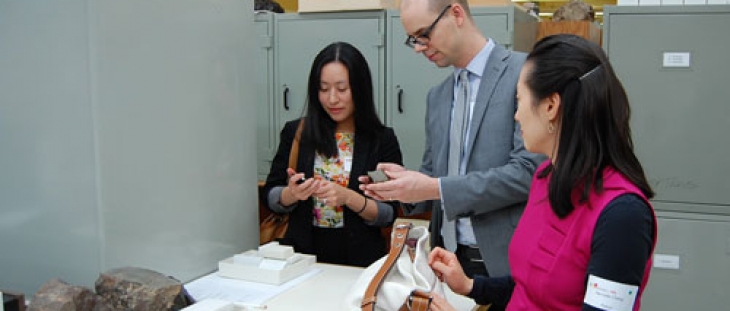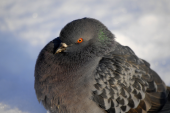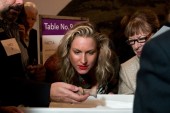
 This past Wednesday night, I held a piece of Mars in my hand (how was your evening?). And then I held a weighty chunk of pure gold – I took the geologist at his word, and resisted biting it. I was at an event held for the Young Patron’s Circle at the Royal Ontario Museum, and this geological pass-around was one of four pit stops on the evening’s tour, which took us behind the scenes, as it were, as scientists and researchers from various departments – the DNA laboratories, Rocks and Minerals, the Rare Book Library and Paleontology – showed us all aspects of their research. Such events are monthly occurrences for the YPC (as they are known amongst each other), and I was asked to tag along on this, their final event of 2011. The Young Patron’s Circle is just that: an ever-growing group of young donors to the ROM. The press release I was given described the YPC as a kind of training program, entry-level philanthropy. The basic door price begins at $600 annually. Broadly speaking, it’s a way of introducing successful young people to the world of cultural sponsorship. The age range of YPC members tends to be from about 25 to 40 years old, and most of the members tend to come from corporate professional backgrounds–PR, communications, law, with some members working in medicine and science. Instead of tedious trustee meetings, donors are treated to events like these: some wine, some cheese and crackers, a little light networking and a tour of the museum.
This past Wednesday night, I held a piece of Mars in my hand (how was your evening?). And then I held a weighty chunk of pure gold – I took the geologist at his word, and resisted biting it. I was at an event held for the Young Patron’s Circle at the Royal Ontario Museum, and this geological pass-around was one of four pit stops on the evening’s tour, which took us behind the scenes, as it were, as scientists and researchers from various departments – the DNA laboratories, Rocks and Minerals, the Rare Book Library and Paleontology – showed us all aspects of their research. Such events are monthly occurrences for the YPC (as they are known amongst each other), and I was asked to tag along on this, their final event of 2011. The Young Patron’s Circle is just that: an ever-growing group of young donors to the ROM. The press release I was given described the YPC as a kind of training program, entry-level philanthropy. The basic door price begins at $600 annually. Broadly speaking, it’s a way of introducing successful young people to the world of cultural sponsorship. The age range of YPC members tends to be from about 25 to 40 years old, and most of the members tend to come from corporate professional backgrounds–PR, communications, law, with some members working in medicine and science. Instead of tedious trustee meetings, donors are treated to events like these: some wine, some cheese and crackers, a little light networking and a tour of the museum.  As I made my way over to the ROM, I wasn’t entirely sure what I was getting myself into. I ascended the steps of the Weston Family Entrance on Queen’s Park Circle, flanked by two great stone lions. At the top, a security guard asked me, sternly but politely, where I was headed. I uttered the magic code word – “YPC” – and I was told where to go. There’s something about the austerity of the ROM combined with that quick little ritualistic back-and-forth that made me feel like I was about to be initiated into the Masons or the Skull and Bones Society. In truth, the YPC event was much more in the order of a corporate Christmas party. Everyone was smartly dressed in typical office wear – ladies in varying shades of black and grey, with pointy towering heels; gentlemen in smart, sensible shoes, shirts and slacks – and gathered around various tables, sipping on cranberry sodas, snacking on obscenely long bread sticks, and chatting jovially. I might not have known what was about to unfold, but everyone there maintained an atmosphere of genial excitement (which, as a scarred veteran of art openings, is not something I encounter often in museums). Opening statements were made, the evening’s itinerary explained, and off we went, split into groups for ease of circulation.
As I made my way over to the ROM, I wasn’t entirely sure what I was getting myself into. I ascended the steps of the Weston Family Entrance on Queen’s Park Circle, flanked by two great stone lions. At the top, a security guard asked me, sternly but politely, where I was headed. I uttered the magic code word – “YPC” – and I was told where to go. There’s something about the austerity of the ROM combined with that quick little ritualistic back-and-forth that made me feel like I was about to be initiated into the Masons or the Skull and Bones Society. In truth, the YPC event was much more in the order of a corporate Christmas party. Everyone was smartly dressed in typical office wear – ladies in varying shades of black and grey, with pointy towering heels; gentlemen in smart, sensible shoes, shirts and slacks – and gathered around various tables, sipping on cranberry sodas, snacking on obscenely long bread sticks, and chatting jovially. I might not have known what was about to unfold, but everyone there maintained an atmosphere of genial excitement (which, as a scarred veteran of art openings, is not something I encounter often in museums). Opening statements were made, the evening’s itinerary explained, and off we went, split into groups for ease of circulation.  The reason a magician never reveals their tricks is not out of fear of plagiarism, it’s out of fear of banality. Watching David Copperfield make the Statue of Liberty disappear is exciting. Watching David Copperfield fiddle with the angle of a mirror, less so. This thought occurred to me as we started our “Cabinet of Curiosities” behind-the-scenes tour. Behind all the austere limestone, the oak display cases guarding the arcane treasure of far-flung cultures, eras and galaxies, is, as it turns out, a series of flatly lit offices with linoleum tile floors outfitted with outdated computers. A DNA Replicator might sound like something out of a science-fiction movie, but in reality, it looks like a small Xerox machine. The surroundings might have been tedious, but the content of the presentations was genuinely fascinating, if somewhat over everyone’s heads. When technician Oliver Haddrath had finished his presentation on the wider implications of the ROM’s DNA research labs and gamely asked if we had any questions, my mind reeled: I had every question! But having them all answered would be tantamount to a crash course in biogenetic forensics, and we only had 10 minutes. From there, we went on to Mineralogy and Ian Nicklin initiated the aforementioned show-and-tell of the highlights of the ROM’s mineral collection. This seemed to be our group’s favorite. Certainly, it was the most tactile, and Nicklin had a gift for concise explanation. And it really is hard to maintain adult composure while manhandling a piece of Mars. Head Librarian Arthur Smith curated a selection of art and design books for display from the Rare Book Library (my personal favorite of all the presentations), and Associate Curator of Invertebrate Paleontology (how’s that to put on a business card?) Jean-Bernard Caron showed us the tracks left by a monstrous Cambrian-era underwater predator in a chunk of the Burgess Shale. And then we adjourned for wine and cheese. These forays into the research aspects of the ROM are more than just simply a treat for YPC members; it reflects one of the missions of the group. In addition to supporting the ROM, member donations establish a research fund (the inaugural fund recipient is currently in Oman, researching a rare kind of weaving indigenous to the area; members are kept abreast of her research via letters that are posted on the YPC website). Still, the treat aspect of these tours should not be taken lightly. As I spoke with a number of members about why they joined the club in the first place, most of them waxed nostalgic about childhood visits to the ROM. In that light, the YPC program is a kind of fundraising masterstroke. First of all, these tours are the kinds things you wished you could go on as a kid, and YPC-ers respond in kind (there were audible, child-like whispers of “waaaoooow” and “coooool!” at various points in the tour). Moreover, these tours foster a deep appreciation, not only of what goes on behind the scenes at the ROM, but for how their research extends beyond the walls of the museum. In effect, YPC-ers are treated to the most convincing object lesson in the importance of such institutions. To put it crassly, they are getting bang for their buck. And with these displays of institutional fireworks, the ROM is ensuring the fundraising equivalent of brand loyalty, growing their Young Patrons into mature, lucrative donors. Sholem Krishtalka writes regularly about art for Toronto Standard. Follow the Young Patrons Circle on Twitter @YPCROM.
The reason a magician never reveals their tricks is not out of fear of plagiarism, it’s out of fear of banality. Watching David Copperfield make the Statue of Liberty disappear is exciting. Watching David Copperfield fiddle with the angle of a mirror, less so. This thought occurred to me as we started our “Cabinet of Curiosities” behind-the-scenes tour. Behind all the austere limestone, the oak display cases guarding the arcane treasure of far-flung cultures, eras and galaxies, is, as it turns out, a series of flatly lit offices with linoleum tile floors outfitted with outdated computers. A DNA Replicator might sound like something out of a science-fiction movie, but in reality, it looks like a small Xerox machine. The surroundings might have been tedious, but the content of the presentations was genuinely fascinating, if somewhat over everyone’s heads. When technician Oliver Haddrath had finished his presentation on the wider implications of the ROM’s DNA research labs and gamely asked if we had any questions, my mind reeled: I had every question! But having them all answered would be tantamount to a crash course in biogenetic forensics, and we only had 10 minutes. From there, we went on to Mineralogy and Ian Nicklin initiated the aforementioned show-and-tell of the highlights of the ROM’s mineral collection. This seemed to be our group’s favorite. Certainly, it was the most tactile, and Nicklin had a gift for concise explanation. And it really is hard to maintain adult composure while manhandling a piece of Mars. Head Librarian Arthur Smith curated a selection of art and design books for display from the Rare Book Library (my personal favorite of all the presentations), and Associate Curator of Invertebrate Paleontology (how’s that to put on a business card?) Jean-Bernard Caron showed us the tracks left by a monstrous Cambrian-era underwater predator in a chunk of the Burgess Shale. And then we adjourned for wine and cheese. These forays into the research aspects of the ROM are more than just simply a treat for YPC members; it reflects one of the missions of the group. In addition to supporting the ROM, member donations establish a research fund (the inaugural fund recipient is currently in Oman, researching a rare kind of weaving indigenous to the area; members are kept abreast of her research via letters that are posted on the YPC website). Still, the treat aspect of these tours should not be taken lightly. As I spoke with a number of members about why they joined the club in the first place, most of them waxed nostalgic about childhood visits to the ROM. In that light, the YPC program is a kind of fundraising masterstroke. First of all, these tours are the kinds things you wished you could go on as a kid, and YPC-ers respond in kind (there were audible, child-like whispers of “waaaoooow” and “coooool!” at various points in the tour). Moreover, these tours foster a deep appreciation, not only of what goes on behind the scenes at the ROM, but for how their research extends beyond the walls of the museum. In effect, YPC-ers are treated to the most convincing object lesson in the importance of such institutions. To put it crassly, they are getting bang for their buck. And with these displays of institutional fireworks, the ROM is ensuring the fundraising equivalent of brand loyalty, growing their Young Patrons into mature, lucrative donors. Sholem Krishtalka writes regularly about art for Toronto Standard. Follow the Young Patrons Circle on Twitter @YPCROM.














